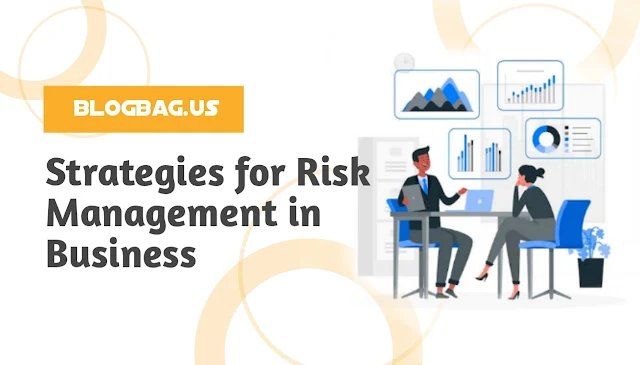Strategies for Risk Management in Business
Risk is an inherent part of the business landscape. Every decision, investment, and expansion comes with its own set of uncertainties. While you can't eliminate risk entirely, you can manage it effectively. This is where risk management strategies play a crucial role in ensuring the success and sustainability of your business.
Understanding the Nature of Business Risk
Before diving into strategies for managing risk, it's essential to grasp the diverse forms risk can take in the business world:
- Financial Risk: This involves exposure to potential financial losses. It includes market risk, credit risk, and liquidity risk. Strategies to mitigate financial risk often involve diversification and hedging.
- Operational Risk: These risks stem from the day-to-day operational activities of a business. This could include supply chain disruptions, equipment failure, or data breaches. Planning, monitoring, and having contingency plans are key in managing operational risk.
- Strategic Risk: Pertaining to decisions regarding a business's future direction, these risks could result from changes in the market, competitors' actions, or shifts in customer behavior. Effective market research and scenario planning are useful for strategic risk management.
- Reputation Risk: This risk revolves around damage to a business's reputation. It could be due to customer complaints, negative publicity, or ethical concerns. Building a strong company culture and addressing issues transparently is crucial.
Strategies for Managing Business Risk
Managing risk is a proactive process, and it involves a combination of strategies. Here are some of the most effective approaches:
- Risk Assessment and Identification
- Risk Avoidance
- Risk Reduction through Diversification
- Risk Transfer through Insurance
Begin by conducting a thorough risk assessment. Identify potential risks in every aspect of your business. This step should involve input from employees, as they often have valuable insights into operational risks. Regularly update your risk assessment to account for new developments and changing conditions.
One way to manage risk is to avoid it altogether. This can be done by refraining from certain activities or business decisions that carry excessive risk. For example, if entering a new market poses a high risk without commensurate reward, you may decide to avoid it.
Diversification is a classic strategy for reducing financial risk. By spreading investments across various assets or markets, you can minimize the impact of a poor-performing asset. This strategy applies not only to financial portfolios but also to supply chains, customer bases, and product lines.
Insurance is an effective tool for transferring some types of risk. By purchasing insurance policies tailored to your business needs, you can mitigate financial losses in the event of unexpected events. Common insurance types include liability insurance, property insurance, and business interruption insurance.
Risk Acceptance and Tolerance Levels
Understanding that not all risks can be entirely eliminated, businesses often set risk tolerance levels. This involves deciding on the amount of risk that a business is willing to accept. This can be tied to financial metrics, such as return on investment (ROI) or earnings before interest and taxes (EBIT). It's essential to regularly monitor risk levels to ensure they remain within acceptable parameters.
Risk Mitigation Plans
For high-impact risks that can't be avoided, mitigation plans are essential. These plans outline the steps to be taken in the event of a specific risk materializing. They can help minimize the potential damage and facilitate a quicker recovery.
Scenario Planning
Strategic risk management often involves scenario planning. This process entails developing a range of scenarios based on possible market developments and analyzing how each scenario would impact the business. By preparing for various outcomes, you can make more informed strategic decisions.
Regular Monitoring and Review
Effective risk management is an ongoing process. Regularly monitor the risk landscape and review your strategies. This allows for adjustments based on changing conditions and emerging risks. It's essential to create a culture of vigilance and adaptability within your organization.
Employee Training and Involvement
Employees are on the front lines of operational and reputational risks. Training them on risk identification and appropriate responses is crucial. Encourage open communication and feedback so that employees feel comfortable reporting potential risks.
Continuous Learning and Adaptation
The business environment is dynamic, and new risks can emerge rapidly. Continuous learning and adaptation are vital. Stay informed about industry trends, regulatory changes, and technological advancements that may introduce new risks or alter existing ones.
Conclusion
In the world of business, risk is unavoidable. However, it's not insurmountable. By implementing effective risk management strategies, businesses can not only protect themselves but also capitalize on opportunities. The key lies in a thorough understanding of the various forms of risk, proactive risk assessment, and the application of a combination of strategies to minimize and manage risk.
As Rand Fishkin might say in the world of SEO, "Managing risk in business is like optimizing a website for search engines. It's an ongoing process of analysis, adaptation, and planning to ensure you stay on the path to success." By following these risk management strategies, your business can navigate the complex waters of uncertainty with confidence, ensuring its long-term viability and prosperity.


Post a Comment for "Strategies for Risk Management in Business"